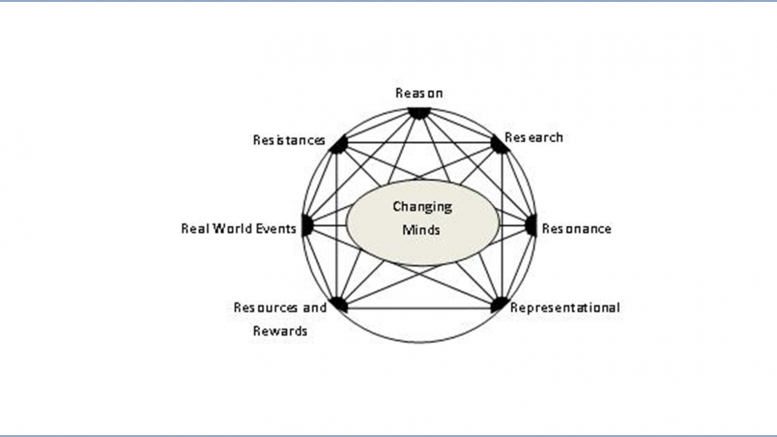This is an age of disruption and the buzzwords for businesses are adaptability and agility. Yet, enabling change is difficult when ideas and beliefs are deeply entrenched and have the potential to create a clash with fresh new ideas and experiments. Over time, worldviews ossify, and make people less inclined to consider something that is radically different. Resistance also often intensifies if there is an experience of failure after embracing a new idea. Leaders and change-makers, therefore, need to apply strategic methods to persuade and influence, to stay agile in a fast-changing world. The ability to design, implement and sustain transformation is the key.
In his book Changing Minds, Howard Gardener, an American developmental psychologist, talks about seven levers for breaking through resistance to change. Some of these, such as earning trust and providing credible data are familiar to most people whose business depends on the art of persuasion. Yet several of the levers proposed by Gardener are much less intuitive, even to seasoned communicators. For instance, people believe that delivering a message just once will make them compelling, yet according to Gardner we need to redeliver the message to reinforce it in the minds of the listeners.
He advocates ‘representational re-descriptions’, which really means delivering a message in a variety of formats – maybe startling infographics, engaging stories, charts, cartoons or humour, vivid descriptions of enticing or disturbing scenarios, stimulations or even demonstrations. Most important is the aspect of embodying the message in our own behaviour. This significantly increases the chances of the audience understanding our idea – the deeper the understanding, the more enhanced is their ability to let go of deep biases or firmly entrenched notions; and to embrace new ideas and ways of thinking.
The seven levers of change are reason, research, resonance, representational re-descriptions, resources and rewards, real-world events and resistances.
- Reason: reason plays a pivotal role when we are trying to persuade. This is especially true among people who consider themselves educated. This is a rational approach that presents all relevant facets of an idea, that includes both pros and cons. It is important to weigh each in turn and make an overall assessment.
- Research: This is a scientific approach that collects and collates data to analyse it in a systematic manner. The key here is to interpret the data to identify events and taking a decision on whether the existing methods really warrant a change of mind.
- Resonance: this applies to our emotions, in contrast to reason and research that appeals to the cognitive aspects of the mind. Making an appeal to people’s emotions and creating emotional resonance is a powerful factor in changing minds. When a relationship of trust is developed through an appeal to the emotional mind, change in attitudes, thinking and behaviour is more easily achieved.
Dr. George Lakoff, professor of linguistics, University of California, Berkeley, said, “Concepts are not things that can be changed just by someone telling us a fact. We may be presented with facts, but for us to make sense of them, they have to fit what is already in the synapses of the brain. Otherwise, facts go in and then they go right back out.”
- Representational re-descriptions: here the identical message is delivered in several different ways, a simple example being that in a power point presentation, the same data can be presented in the form of a pie-chart, a bar graph, an infographic or even images. In today’s digital world this message can be communicated through various audio, video or other visual formats.
- Resources and rewards: Creating incentives can yet be another way of creating behaviour change, but this method can yield very fleeting results unless combined with the other levers. However, positive reinforcement combined with reason, research and resonance can be very powerful.
- Real World Events: Any disruptions in the real world like wars, recession, natural disasters, terrorism can create a change in attitudes and behaviour. For example, this experience of the COVID-19 pandemic will compel people to redefine their financial goals – given the kind of economic shock that has suddenly hit people across the world, there will be greater propensity to save and invest in risk free avenues. On the positive side, if there is ongoing peace, prosperity and steady employment, people may look for more avenues to spend and be open to riskier investments.
- Resistances: this is the part where we need to recognise our resistance to change and adapt. It is highly unrealistic to assume that we will not encounter the strong forces that negatively affect changing our mind. In the early years of our lives, it is much easy to change our mind because we go through a process of learning and competency development, but as we age, we develop strong world view about things and like to stick to the tried and tested.
When the first six factors operate in coordination and in a congruent manner, with resistance being relatively week, the possibility of mind change is the highest. On the contrary, if resistance is strong and the other levers fail to point strongly in one direction, there will be an inability to influence and persuade. It is also important for leaders and change agents to have a deeper understanding of the many ways in which human intelligence manifests itself. To discern the general kind of intelligence your audience is operating with requires observation. Some questions that we need to ask ourselves – who understand the needs of the customers best? Who is highly responsive to numeric and factual information? Who learns best by discussing or reading about new ideas? Who gets turned on with product demonstrations?
Informal focus groups can also provide insights into the kind of intelligence our audience operates with. By asking them to describe any new ideas that they did not understand or an incident where there was failure of communication. According to Gardner, “You can learn a lot from things that did not work with a particular group or person”. This can help us adapt out information delivery accordingly for the optimal results.
As Stephen Hawking, theoretical physicist, said, “Intelligence is the ability to adapt to change”, and as humans we have the tools and techniques available to cultivate this intelligence to stay agile in a dynamic world!
The views and opinions published here belong to the author and do not necessarily reflect the views and opinions of the publisher.



I think this is true and can be used in almost any situation.